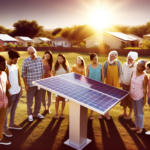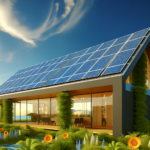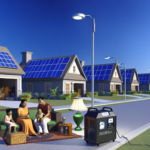Introduction to Solar Power in Emergencies
The importance of being prepared for emergencies
Emergencies, whether natural disasters or human-made crises, can strike at any time, often with little warning. Being prepared for such events is crucial for ensuring the safety and well-being of individuals and communities. A key component of emergency preparedness is ensuring access to reliable power sources, which can be compromised during such times. Power outages can disrupt communication, access to clean water, and the functioning of essential medical equipment, making it imperative to have alternative energy solutions in place.
Overview of solar power as a sustainable solution
Solar power stands out as a sustainable solution for emergency power needs. Unlike conventional power sources that rely on fuel supply chains, which can be disrupted during emergencies, solar power harnesses the sun’s energy, providing an inexhaustible and readily available resource. Solar installations can be deployed quickly and can operate independently of the grid, making them ideal for emergency situations where traditional power infrastructure may be damaged or overloaded.
Advantages of solar power in emergency situations
- Reliability: Solar power systems can provide consistent energy during emergencies, as they do not rely on fuel that may be difficult to obtain during such times.
- Portability: Portable solar solutions, such as solar-powered generators and solar panels, can be easily transported and set up in various locations, offering flexibility in emergency response.
- Sustainability: By using a clean energy source, solar power reduces the environmental impact during disaster response efforts, aligning with broader goals of sustainability and carbon footprint reduction.
- Scalability: Solar power systems can be scaled to meet different energy needs, from charging individual devices to powering entire communities, making them versatile tools in emergency management.
In conclusion, solar power’s unique attributes make it a powerful ally in emergency preparedness and response. Its ability to provide reliable, sustainable, and scalable power can be life-saving in times of crisis, underscoring the importance of integrating solar solutions into emergency planning and infrastructure.
Understanding Solar Power Basics
How solar power works
Solar power harnesses the energy from the sun and converts it into usable electricity. The process begins with solar panels, which are composed of many solar cells. These cells are made from materials like silicon that exhibit a photovoltaic effect—meaning they can generate an electric current when exposed to sunlight. When photons from sunlight hit the solar cells, they knock electrons loose from their atoms, allowing the electrons to flow through the material to produce electricity. This flow of electrons is what we call an electric current, which can be harnessed for power.
Components of a solar power system
- Solar Panels: The most visible part of a solar power system, these panels contain the photovoltaic cells that convert sunlight into electricity.
- Inverter: This device converts the direct current (DC) electricity produced by the panels into alternating current (AC) electricity, which is the standard used by most home appliances.
- Battery Storage (optional): Batteries can store solar energy for use when the sun isn’t shining, such as during the night or on cloudy days.
- Mounting System: The structure that securely attaches the solar panels to a roof, ground, or pole.
- Charge Controller: If a battery is used, this component regulates the flow of electricity to and from the battery to prevent overcharging or over-discharging.
The efficiency of solar panels
The efficiency of solar panels is a measure of a panel’s ability to convert sunlight into usable electricity. It is typically expressed as a percentage. Most commercial solar panels have efficiencies ranging from 15% to 20%, though some high-efficiency models can exceed 22%. Factors that affect solar panel efficiency include the type of photovoltaic material used, the quality of manufacturing, and the amount of sunlight the panel receives.
Maintenance and longevity of solar power systems
Solar power systems are known for their durability and low maintenance requirements. Most systems do not have moving parts, which minimizes wear and tear. Regular maintenance typically involves keeping the panels clean and free of debris to ensure maximum light absorption. The longevity of a solar power system can be substantial, with many systems designed to last 25 to 30 years or more. Inverters may require replacement sooner, typically after 10 to 15 years of service. Proper maintenance can help extend the life of all components and ensure the system operates at peak efficiency.
Solar Power in Different Emergency Scenarios
Natural disasters and power outages
In the wake of natural disasters such as hurricanes, earthquakes, and wildfires, power outages can last for days or even weeks. Solar power emerges as a beacon of self-reliance during these times. Solar panels and battery storage systems can provide critical electricity for lighting, communication, and essential medical equipment. For instance, during wildfires, solar generators can power emergency shelters, keeping lights on and communication lines open. Moreover, solar-powered water purification systems ensure access to clean drinking water, a vital resource often compromised during disasters.
Off-grid living and remote locations
For those living off the grid or in remote areas where traditional power infrastructure is non-existent or unreliable, solar power is not just an emergency solution but a way of life. In these scenarios, solar energy systems are designed to meet all electricity needs, from daily usage to emergency situations. Solar power provides independence from the grid, ensuring that residents have a consistent power supply regardless of external circumstances.
Adventures and outdoor activities
Adventurers and outdoor enthusiasts often find themselves in areas where the grid cannot reach. Solar power offers a sustainable solution to keep devices charged and campsites illuminated. Portable solar chargers, lights, and even solar-powered stoves ensure that the adventure can continue safely without leaving a carbon footprint.
Emergency preparedness kits
Having a solar-powered emergency preparedness kit is essential for any household. Key items include:
- Solar-powered lights and lanterns: These provide illumination without the need for grid electricity or disposable batteries.
- Solar-powered radio: A crucial tool for staying informed about emergency broadcasts and weather conditions.
- Solar-powered cell phone chargers or power stations: These ensure communication devices remain operational, which can be lifesaving in emergencies.
- Solar showers: These offer a way to maintain hygiene when hot water access is disrupted.
- Solar generators: While more expensive, they offer a long-term solution for powering various devices and appliances.
Each of these tools harnesses the sun’s energy to provide a reliable and renewable source of power, ensuring that even during the most challenging times, one can maintain a degree of normalcy and safety.
Choosing the Right Solar Power Solutions
Assessing Energy Needs During an Emergency
When preparing for emergencies, it’s crucial to assess your energy needs accurately. Start by identifying essential appliances and devices that require power, such as refrigerators, lights, communication devices, and medical equipment. Calculate the total wattage needed to run these essentials and consider the duration they must operate. This will help determine the size and capacity of the solar power system required to sustain your household during an emergency.
Portable vs. Fixed Solar Power Systems
Choosing between portable and fixed solar power systems depends on the specific needs and circumstances. Portable solar panels are ideal for temporary situations or when mobility is necessary, such as camping trips or temporary shelters. They are typically smaller, easy to set up, and can be moved to capture optimal sunlight. On the other hand, fixed solar power systems are more suitable for permanent residences or long-term emergency preparedness. These systems are installed on rooftops or ground mounts and are designed to provide a larger and more stable power supply.
Key Features to Look for in Solar Equipment
- Durability: Look for solar panels and components that are built to withstand harsh weather conditions, including high winds and hail.
- Efficiency: Higher efficiency panels will generate more electricity in a given area, which is crucial when space is limited.
- Battery Storage: A reliable battery system is essential for storing solar energy, ensuring power availability during nighttime or cloudy days.
- Expandability: Consider systems that allow for future expansion, as energy needs may increase over time.
Budget Considerations
While the initial cost of solar power systems can be significant, various federal and state incentives can reduce the upfront investment. Additionally, the long-term savings on utility bills and the potential to sell excess energy back to the grid can make solar power a financially viable solution. It’s important to balance the upfront costs with the expected energy savings and the value of having a reliable power source during emergencies. When budgeting, factor in not only the cost of the solar panels but also the installation, battery storage, and any additional components needed for a complete system.
Ultimately, the right solar power solution will depend on individual energy needs, the types of emergencies anticipated, and budget constraints. By carefully considering these factors, you can select a solar power system that ensures sustainable survival when it matters most.
Installation and Usage Tips
Setting up a Solar Power System
Installing a solar power system is a strategic step towards energy independence and resilience in emergencies. Begin by selecting a suitable location with maximum sun exposure, ideally south-facing in the Northern Hemisphere. Mount the solar panels securely to avoid damage from environmental factors. Connect the panels to a charge controller, which regulates the power to the battery, preventing overcharging. The battery stores energy for use when sunlight is not available, and an inverter converts this stored energy into usable alternating current (AC) for your appliances.
Maximizing Solar Energy Capture
To ensure your solar power system operates at peak efficiency, consider the following:
- Panel Angle: Adjust the tilt angle of your solar panels seasonally to capture the most sunlight.
- Shade Avoidance: Keep panels clear of shadows cast by trees, buildings, or other obstructions throughout the day.
- Cleaning: Regularly clean the panels to remove dust, dirt, and debris that can reduce efficiency.
- Monitoring: Use a monitoring system to track performance and identify any issues promptly.
Safety Precautions and Best Practices
Safety is paramount when dealing with solar power systems. Always follow these guidelines:
- Electrical Safety: Hire a certified electrician for installation to ensure all electrical connections comply with local codes and regulations.
- Weatherproofing: Ensure all outdoor components are weatherproof to withstand harsh conditions.
- Surge Protection: Install surge protectors to safeguard your system from lightning strikes and power surges.
- Regular Inspections: Periodically inspect your system for any signs of damage or wear.
Troubleshooting Common Issues
Even with proper installation and maintenance, you may encounter issues. Here are common problems and solutions:
- Reduced Power Output: Check for and clear any obstructions causing shade. Inspect for dirty or damaged panels.
- Battery Issues: Ensure batteries are properly charged and maintained. Replace if they no longer hold a charge.
- Inverter Failure: Inverters may display error codes indicating specific issues. Refer to the manual for troubleshooting or consider professional assistance.
- Connection Problems: Verify all electrical connections are secure and free of corrosion.
By adhering to these installation and usage tips, your solar power system will be better equipped to provide reliable energy during emergencies, contributing to sustainable survival and peace of mind.
Sustainability and Environmental Impact
Reducing carbon footprint with solar power
The adoption of solar power is a significant step towards reducing the global carbon footprint. By harnessing the sun’s energy, solar power systems produce electricity without emitting greenhouse gases, unlike conventional fossil fuel-based power generation. This transition to a cleaner energy source is crucial in mitigating the effects of climate change. Solar installations can significantly lower carbon emissions for households and businesses, contributing to a more sustainable and environmentally friendly energy landscape.
Solar power and wildlife conservation
Solar power also plays a vital role in wildlife conservation. Traditional energy production can lead to habitat destruction, water pollution, and other environmental hazards that threaten wildlife. In contrast, solar power systems have a minimal impact on the natural environment once installed. They can be placed on rooftiles, in deserts, or on other disturbed lands, avoiding the need to clear new land. Moreover, solar farms can be designed to coexist with local flora and fauna, promoting biodiversity.
Recycling and disposal of solar power components
As solar power systems reach the end of their life, recycling and proper disposal become essential. Solar panels contain materials that can be recycled, such as glass and metal, reducing waste and the need for raw materials. However, some components also include hazardous substances that must be handled correctly. The solar industry is working towards developing more efficient recycling processes and designing panels for easier end-of-life management, ensuring that solar power remains a truly sustainable solution.
The future of solar power in sustainable living
The future of solar power in sustainable living is bright. Technological advancements continue to improve the efficiency and affordability of solar installations, making them accessible to a broader range of people. As public awareness of environmental issues grows, so does the adoption of solar power. This trend is likely to accelerate, with solar energy becoming a cornerstone of sustainable living practices. By integrating solar power into our daily lives, we can build a resilient future that prioritizes the health of our planet and its inhabitants.
In conclusion, solar power is not just an alternative energy source; it’s a pathway to a more sustainable and environmentally conscious way of life. Its ability to reduce carbon emissions, conserve wildlife, and its potential for recyclability and sustainable management make it a key player in the quest for a greener future. As we continue to embrace solar power, we empower sustainable survival, ensuring that our energy choices support the well-being of our planet for generations to come.
Conclusion: Empowering Sustainable Survival
Summarizing the Role of Solar Power in Emergencies
In the face of emergencies, solar power stands out as a beacon of resilience and reliability. Throughout this article, we’ve explored how solar energy systems provide critical power during natural disasters, power outages, and in remote locations where traditional energy sources are unavailable or impractical. The inherent advantages of solar power—its renewability, portability, and low maintenance—make it an indispensable component of any emergency preparedness plan. By harnessing the sun’s energy, individuals and communities can ensure access to essential services, such as lighting, communication, and medical equipment, when they are needed most.
Encouraging Proactive Solar Power Adoption
Adopting solar power should not be a reactive measure, taken only after the occurrence of an emergency. Instead, proactive integration of solar solutions into daily life can pave the way for seamless transitions in times of crisis. Households, businesses, and governments are encouraged to consider the long-term benefits of solar power, not only for emergency scenarios but also for sustainable living. Investing in solar technology today can lead to significant energy independence, cost savings, and a robust safety net for when the unexpected strikes.
Final Thoughts on Building a Resilient Future
The journey towards a resilient future is paved with the adoption of sustainable practices, and solar power is a cornerstone of this transformation. As we look ahead, the role of solar energy in emergency preparedness and sustainable living will only grow in importance. By embracing solar power, we are not only preparing ourselves for the uncertainties of tomorrow but also contributing to a cleaner, greener planet. It is our collective responsibility to foster a world where sustainable survival is not just a concept, but a reality for all. Let us commit to solar power as a key player in our emergency toolkit and a vital component of our sustainable future.






